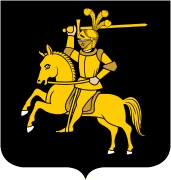Ripperda
Ripperda is the name of an old and prominent family that belongs to the German, Austrian, Spanish and Dutch nobility. Members of this family have played a major role in European history as soldiers, politicians and diplomats.
| Ripperda | |
|---|---|
| noble family | |
 | |
| Country | |
| Founded | 14th century |
Origins
The origins of the name are not completely clear but the family seems to originate from East Frisia, settling in the north-eastern part of the Netherlands (de Ommelanden), the current province of Groningen, in the 14th century. The name Ripperda is probably derived from the man's name Rippert (Rupert). This was not uncommon among Frisian families.
Barons
In 1474, Frederick III, Holy Roman Emperor conferred upon Unico II Ripperda and all his descendants the title of baron with Imperial immediacy (“Reichsunmittelbarer Häuptling und Freiherr”) and the right to issue coins ("muntrecht"). On 3 September 1676, Leopold I, Holy Roman Emperor recognised this nobility diploma and confirmed the title of baron ("Reichsfreiherr") for all members of the house of Ripperda.
From the 11th century, members of this family had ruled as local chiefs in the provinces of Groningen and East Frisia. Later, they also belonged to the local nobility of Drenthe, Overijssel, Zutphen, Münster and Minden, among others. Their influence and wealth continued to increase throughout The Netherlands and Westphalia with the help of advantageous marriages and alliances. At their zenith, in the 17th and 18th centuries, the Ripperdas were among the most powerful and wealthiest nobles in the region. As such, they are closely related to a number of other prominent noble families.




Ripperdas today
The Dutch branches of Ripperda-Farmsum, -Oosterwijtwerd, -Winsum, -Vorden and -Weldam had all died out by the early 19th century. The Dutch-German branch of Ripperda-Petkum died out in 1739; the Dutch-Austrian branch of Ripperda-Boxbergen in 1920; and the German branch of Ripperda-Ellerburg shortly after World War II. Today, three Danish members of the branch of Ripperda-Ellerburg (a.k.a. "de Ripperda") survives in Copenhagen, and five of the Dutch-German branch, von Ripperda-Cosyn, in London and Paris.
In addition, numerous descendants of an illegitimate son of John Willem Ripperda listed below) exist in Lingen (Germany) and the United States. However, the latter have never belonged to the nobility and are not formally recognised by the family.
Famous scions
Sources
- "Genealogie van het Geslacht Ripperda" by mr. C.P.L. Rutgers (1902).
- "Genealogie van het Geslacht Ripperda" by Pieter van Agteren (2014).
- "Het Geslacht Ripperda" by R.S. Roorda (1954).
- "Genealogie über 16 Generationen des Reichsfreiherrlichen Geschlechtes von Ripperda" by Udo Reichsfreiherr von Ripperda (Köningsberg, 1934).
- "Huisarchief van Farmsum" in the archives of the Hoge Raad van Adel (High Council for Nobility), The Hague.
- "Johan Willem Ripperda – De man die geen koning werd van Corsica" by Sytze van der Veen (2007).
- Von Ripperda family-archive.
- "Gothäisches Genealogisches Taschenbuch der Freiherrlichen Hauser" (1894, 1904, 1942)
- "Genealogisches Handbuch des Adels - Band 122, Adelslexikon XI Pre-Rok" (2000)
- "Portraits of the House of Ripperda - A Catalogue" by Charles F. Ponsonby (2016)